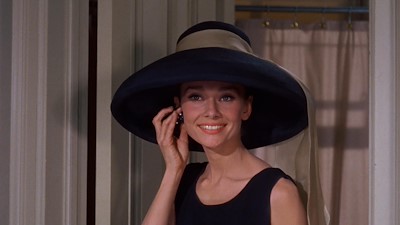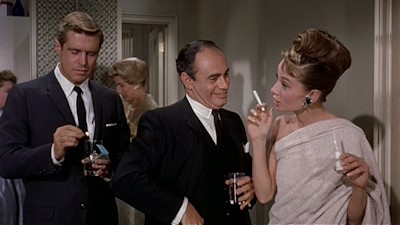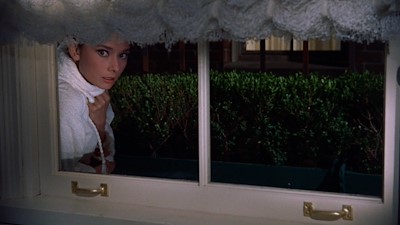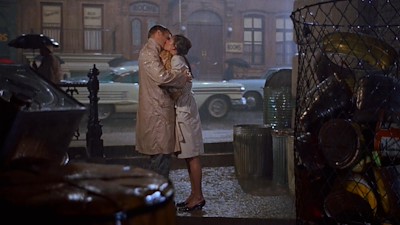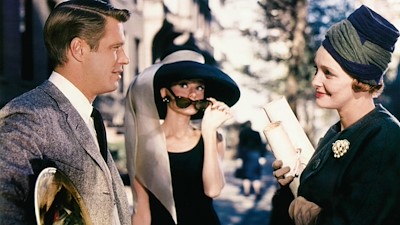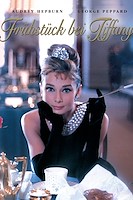Breakfast at Tiffany's
Blake Edwards, USA, 1961o
Fortune hunter Holly Golightly finds herself captivated by aspiring writer Paul Varjak, who's moved into her building on a wealthy woman's dime. As romance blooms between Paul and Holly, Doc Golightly shows up on the scene, revealing Holly's past.
An unusual love story, glamorous, sophisticated, with more than a touch of the bizarre. Breakfast at Tiffany's looks like a box office favorite. The Martin Jurow-Richard Shepherdproduction for Paramount has good names to add to its appeal, including an appealing performance by Audrey Hepburn. Blake Edwards directed.
The film bears only a slight resemblance to the Truman Capote novelette on which it is based. Capote's work was a minor tragedy. The screenplay by George Axelrod turned the story into a romantic comedy. It has suggestions of grimmer moments, but they are played now only for contrast for what is, eventually, a happy ending. It will be disappointing to admirers of the Capote work, but they are few in number compared to those who will be attracted to and enjoy the film.
Miss Hepburn plays the central figure, a woman like many others in Manhattan, who dresses well and dines well, living chiefly on the "ladies room" change given her by her escort. If the escort of the evening thinks a $50 "tip" pays for something later, this is not how Miss Hepburn plays it. She is, the picture makes clear, immoral but virtuous. Her values undergo a change from her exposure to George Peppard, a young writer, who convinces her responsibility is less confining than her studied irresponsibility.
Edwards' direction is smart; he has a way with fashionable comedy. Axelrod's treatment of the Capote story is convincing in the changes it has made although some of his devices are disappointing, being overly familiar. The script is not altogether neat. No justification or explanation is ever made of why Peppard is being kept by a wealthy lady, except that he is a writer and writers, presumably, get involved in things like that.
Miss Hepburn is responsible to a great degree for the credibility of her complex character and gives a winning portrayal. Peppard virtually overcomes the script deficiencies in his character, because he is an exceptionally virile young leading man who achieves the aura of manliness without sweat. Patricia Neal is strong as Peppard's lady friend. Martin Balsam gives a wonderfully flexible portrait of a Hollywood agent. Buddy Ebsen has charm as Miss Hepburn's whilom husband. Mickey Rooney gives his customary all to the part of a Japanese photographer, but the role is a caricature and will be offensive to many. Others helpful include Villanoga, John McGiver, Dorothy Whitney, Stanley Adams, Elvira Allman and Alan Reed.
Franz Planer's Technicolor photography is beautifully balanced, the color for once the same tones throughout, whether exteriors or studio shots. Hal Pereira and Roland Anderson have done imaginative settings, with good set decoration by Sam Comer and Ray Moyer. Sound byHugo Grenzbach and John Wilkinson is first-rate, and William McGarry's editing is excellent.Henry Mancini's score is another plus.
James PowersWhat makes Tiffany’s an appealing tale is its heroine, Holly Golightly, a charming, wild and amoral ‘free spirit’ with a latent romantic streak. Scenarist George Axelrod’s once-over-go-lightly erases the amorality and bloats the romanticism, but retains the essential spirit (‘a phony, but a real phony’) of the character, and, in the exciting person of Audrey Hepburn, she comes vividly to life on the screen.
Hepburn’s expressive, ‘top banana in the shock department’ portrayal is complemented by the reserved, capable work of George Peppard as the young writer whose love ultimately (in the film, not the book) enables the heroine to come to realistic terms with herself.
Excellent featured characterizations are contributed by Martin Balsam as a Hollywood agent, Buddy Ebsen as Hepburn’s deserted husband, and Patricia Neal as Peppard’s wealthy ‘sponsor’. Mickey Rooney as a much-harassed upstairs Japanese photographer adds an unnecessarily incongruous note to the proceedings.
The film is a sleek, artistic piece of craftsmanship, particularly notable for Franz F. Planer’s haunting photography and Henry Mancini’s memorably moody score. The latter’s ‘Moon River’, with lyrics by Johnny Mercer, is an enchanting tune.
Eine junge Frau aus der Provinz lässt sich in New York von vermögenden Herren aushalten und macht die Bekanntschaft eines schriftstellerisch ambitionierten jungen Nachbarn, der seinerseits von einer älteren Geliebten alimentiert wird. Die aufkeimende Liebe konfrontiert beide mit ihren Lebenslügen. Der romantische Schauplatz von Blake Edwards' berühmter Capote-Verfilmung spiegelt wunderbar Wunschwelt und Wirklichkeit seiner Figuren: Die schicke Upper East Side steht für den Traum vom mondänen Leben, der schon Millionen junge Provinzler nach New York gebracht hat. Die Single-Apartments eines klassischen Reihenhauses, welche die Helden - ständig beargwöhnt von kleinlichen Nachbarn - in diesem Quartier bewohnen, bergen hingegen Einsamkeit und kleinbürgerliche Ernüchterung. Der märchenhafte Charme von Breakfast at Tiffany's rührt von der Hartnäckigkeit, mit der Audrey Hepburn alias Holly Golightly diese dunkle Seite leugnet und ihre Verlorenheit mit Exzentrik kaschiert. Die Feuertreppe zwischen den Wohnungen der jungen Liebenden ist übrigens ein typisches New Yorker Cliché: Sie wurde speziell für den Film am Haus angebracht.
Andreas FurlerAudrey Hepburns berühmtester Film unter der Regie von Blake Edwards nach Truman Capotes gleichnamiger Erzählung aus dem Jahr 1958. Die Rolle der Holly Golightly, eines charmanten New Yorker Partygirls mit einer Schwäche für Diamanten, verlieh Audrey Hepburn als Hollywoods elfenhaftem Gegenbild zu Marilyn Monroe oder Liz Taylor Unsterblichkeit.
Hollys ausgelassener Flirt mit vermögenden älteren Herren aus Liebe zum Schönen und Teuren gerät aus der Bahn, als sie sich wider Willen in den Schriftsteller Paul Varjak aus der Nachbarschaft verliebt. Sie sieht sich vor die Entscheidung gestellt, ihrem Herzen zu folgen oder ihrer Vorliebe für teuren Schmuck.
Blake Edwards' elegante Komödie über die Dekadenz der Upperclass ist ein Klassiker des Genres. Ursprünglich hätte übrigens Marilyn Monroe die Rolle der Holly Golightly übernehmen sollen, und Audrey Hepburn war nur zweite Wahl, weshalb die Filmkritiker mit Hepburn damals die beste Fehlbesetzung aller Zeiten lobten. Henry Mancinis Filmmusik wurde mit einem Oscar gekrönt.
ces.Galleryo
